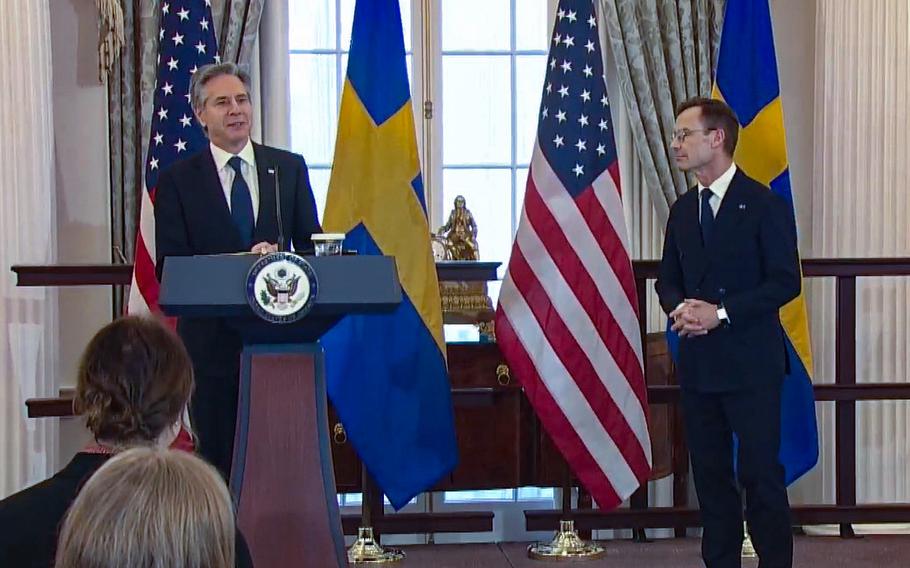
In a video screenshot, U.S. Secretary of State Antony Blinken speaks as Swedish Prime Minister Ulf Kristersson looks on during a ceremony in which Sweden officially joined the North Atlantic Treaty Organization on March 7, 2024. (Facebook/U.S. State Department)
Sweden officially joined the North Atlantic Treaty Organization on Thursday, a historic shift that highlights how Russian President Vladimir Putin’s war in Ukraine is transforming European security in ways he may not have foreseen.
At a meeting in Washington, Swedish Prime Minister Ulf Kristersson deposited the final paperwork with Secretary of State Antony Blinken, the last step needed for the former militarily nonaligned nation to become NATO’s 32nd member. Sweden’s neighbor, Finland, joined last year.
To justify his aggression in Ukraine, Putin cited the possibility of NATO expansion. Now, in one of the conflict’s many twists, his war has brought a bigger, stronger alliance to his door. Russia will have to live with the consequences for years.
“There is no clearer example today of the strategic debacle that Ukraine has become for Russia,” Blinken said Thursday, standing beside an elated Kristersson.
“Everything that Putin sought to prevent, he has actually precipitated by his actions, by his aggression.”
The addition of Sweden and Finland will strengthen NATO in the far north, where Russia keeps much of it second-strike nuclear capability, and boost its presence around the Baltic Sea, particularly around the Russian exclave of Kaliningrad.
Sweden’s navy has experience operating in — and under — Baltic waters, and its fighter jets will patrol the region’s skies, making it easier for NATO to supply or defend Baltic allies, should the need arise. Stockholm has already said it will send troops to join a multinational force based in Latvia.
“Sweden’s accession makes NATO stronger, Sweden safer, and the whole Alliance more secure,” NATO Secretary General Jens Stoltenberg wrote on X.
Kristersson said it was a “historic moment” and pledged that his country would meet the alliance’s defense spending target of 2% of gross domestic product from this year onward.
“Unity and solidarity will be Sweden’s guiding light as a NATO member,” he said. “We will share burdens, responsibilities and risks with other allies.”
Although Sweden’s NATO bid was blocked at various points by Turkey, and then by Hungary, its admission Thursday sends an important signal to Putin as he wages war in Ukraine and threatens other neighbors, said Anna Wieslander, director for Northern Europe at the Atlantic Council.
That message: “That he cannot dictate, and if he does, there will be pushback.”
Russia did not immediately comment on the news. The country’s response to Finnish membership was muted, though Russian officials have talked in general terms about the need to adjust their military posture in response to NATO’s new borders and plans.
A few years ago, it would have been difficult to imagine Sweden joining NATO. Military nonalignment was a part of the country’s identity.
But Russia’s February 2022 invasion of Ukraine seemed to rouse Europe from a post-Cold War slumber, spurring deep changes in how the region’s relatively wealthy democracies think about their own security.
The European Union began the process of weaning itself off Russian oil and gas. It dug into its stockpiles to send weapons to Ukraine. And it has started to step up defense spending - albeit more slowly than many at NATO headquarters or in Washington might like.
NATO, meanwhile, began its biggest overhaul since the Cold War, drawing up new battle plans that are more squarely focused on deterring Russia and defending every inch of NATO territory from day one should Moscow try anything.
When Russian tanks rolled on Kyiv, Finnish sentiment about NATO shifted quickly. Sweden took slightly longer to come around but applied for membership alongside its neighbor in May 2022.
In his remarks Thursday, Blinken noted that most Swedes were not interested in NATO before Russia’s invasion, but Moscow’s actions prompted a dramatic rethink. “Swedes realized something very profound,” he said, “that if Putin was trying to erase one neighbor from the map, then he might not stop there.”
Both countries — and much of the alliance — expected a smooth accession process. But approving newcomers requires unanimity, and it soon became clear that Turkey would object at every step.
What followed was more than 20 months of obstruction and delay from Turkey, followed by stalling from Hungary — public feuding that no doubt pleased Putin.
When it became clear that Turkey’s problem was with Sweden, not Finland, their bids were split. Finland joined last spring, while Sweden kept negotiating.
Turkish President Recep Tayyip Erdogan sought F-16 fighter jets from the United States and insisted that Sweden crack down on groups that Turkey considers to be terrorists. Hungarian Prime Minister Viktor Orban pressed Sweden’s prime minister to visit Budapest and cut a deal to get more Swedish-built fighter jets.
In the end, after much drama and fraught diplomacy, both countries extracted what they could and agreed to welcome another new member.
The Swedish flag will not rise outside NATO’s Brussels headquarters until Monday, officials said, but NATO’s key protection — the collective defense clause known as Article 5 — goes into effect immediately.
“We will go to sleep here tonight with Article 5 embracing this country,” Wieslander, of the Atlantic Council, said in a phone call from Sweden. “That is a huge shift for us.”